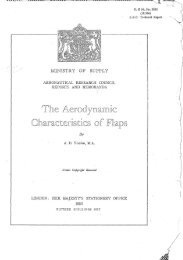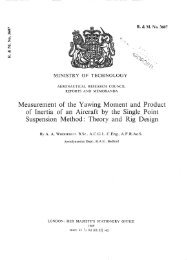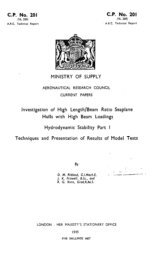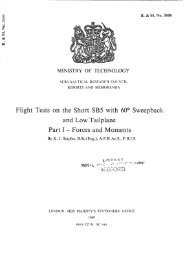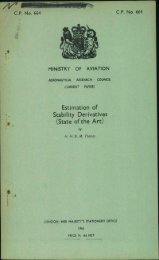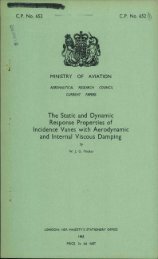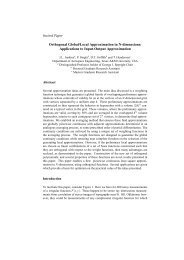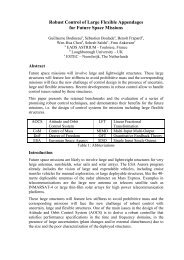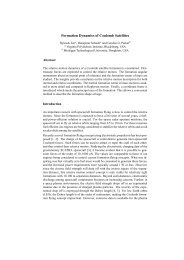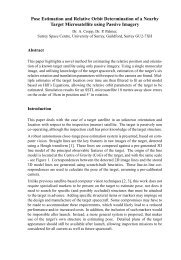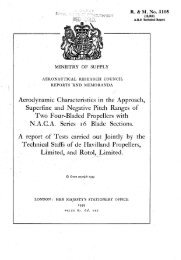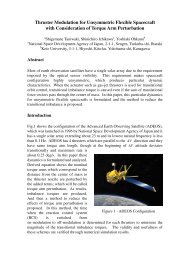A Survey of Unsteady Hypersonic Flow Problems
A Survey of Unsteady Hypersonic Flow Problems
A Survey of Unsteady Hypersonic Flow Problems
You also want an ePaper? Increase the reach of your titles
YUMPU automatically turns print PDFs into web optimized ePapers that Google loves.
-a-<br />
have been ~0nce171ed with the flutter <strong>of</strong> two-dimensional sections with pitching<br />
and plunging freedoms, and. the closely allied problem <strong>of</strong> cantilever wings with<br />
root flexlbilities IA pitching and flapping. The studies <strong>of</strong> flutter <strong>of</strong><br />
two-dimensional sections have shown the effects <strong>of</strong> an altitude parameter @&,,<br />
a thickness parameter &$, and a mean inCidenCe parameter &a,, where p<br />
is the mass ratio <strong>of</strong> the section, 6 is the thxkness ratlo, and as is the<br />
mean incidence. For sharp sections with similar pr<strong>of</strong>iles, the same pitching<br />
axis position, and the same density and mass dxstrlbutions, and ratios <strong>of</strong> the<br />
natural frequency in plunge to that in pitch <strong>of</strong> less than one (which is the<br />
usual condition), flutter speed is approximately proportional to a for<br />
Kc06 and !&,,a, constant; decreases wzth increasing h@ for $& and M,.&,<br />
constant, and it can decrease with increasing &~s for & and &,,6 constant.<br />
The pr<strong>of</strong>ile shape <strong>of</strong> a sharp-nosed section only has a large effect if it causes<br />
a large change in the centre <strong>of</strong> pressure position (e.g., a change from a double<br />
wedge to a single wedge section), but blunting the nose <strong>of</strong> a section at constant<br />
cr14, increases the flutter speed up to a limit <strong>of</strong> blunting that depends on the<br />
Mach number; further bluntug reduces the flutter speed or causes divergence<br />
before the section flutters. It seems possible that the effects <strong>of</strong> strong nose<br />
shock waves, the entropy variations that result from these, and real gas effects<br />
may increase the flutter speed over the value which it would have if these<br />
effects were absent. Finally, when aerodynamic non-linearities are significant,<br />
theoretical investigations have shown that there exists a range <strong>of</strong> speeds within<br />
which flutter can be started by disturbances <strong>of</strong> a finite size - the larger the<br />
disturbance the lower the flutter speed.<br />
The limited investigations <strong>of</strong> the effects <strong>of</strong> chordwise bending modes<br />
on the flutter <strong>of</strong> low aspect ratio wings serve to show that these can be<br />
important (though the effectidaepend on the characteristics <strong>of</strong> the particular<br />
structure) and that flutter <strong>of</strong> a slender wing involving only longitudinal bending<br />
modes 1s possible. The flutter analysis and experiment on a rigid cone with<br />
pitching and plunging flexibillties suggest that the flutter speed/altitude<br />
parameter for a given cone is independent <strong>of</strong> Mach number.<br />
There do not seem to have been any investigations <strong>of</strong> panel flutter at<br />
hypersonic speeds, but, sinoe structural limitations ensure that the<br />
displacements are very small so that the hypersonic parameter &6 (where 6 is<br />
a measure <strong>of</strong> the displacement) remains small, some deductions about panel flutter<br />
behavlour can be made from the results <strong>of</strong> investigations at lower Mach numbers.<br />
On this basis, panel flutter seems unlikely to be influenced by fluid dynamic<br />
effects <strong>of</strong> high Mach numbers, except by those arising from the thickness <strong>of</strong> the<br />
boundary layers; but critical conditions could arise in practice because strong<br />
shock waves will increase the values <strong>of</strong> local dynamic pressures above those for<br />
the free stream, and the stiffness and end loadings <strong>of</strong> panels will increase as<br />
a result <strong>of</strong> aerodynamic heating <strong>of</strong> the structure.<br />
The investigations <strong>of</strong> flutter that have been examined are all concerned<br />
with rather special cases; nevertheless, they all suggest that purely fluid<br />
dynamic effects at high Mach numbers will not have a large Influence on the<br />
likelihood <strong>of</strong> flutter. For example, for a two-dimensional section, although<br />
leading edge blunting and a large mean incidence can cause reductions in the<br />
flutter margin at high Mach numbers, present information suggests that, for flight<br />
at constant pressure, and when the effect <strong>of</strong> aerodynamic heating on structural<br />
stiffness 1s ignored, the transonic flight &gime remains as the most critical.<br />
On the other hand, flutter could be a danger at hypersonxc speeds because<br />
aerodynamic heating could alter the stiffness <strong>of</strong> a structure and for sOme flight<br />
paths, partxularly during re-entry, high dynamic pressures occur when the heating<br />
rate/



